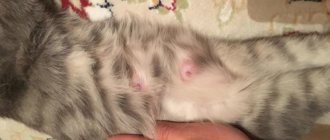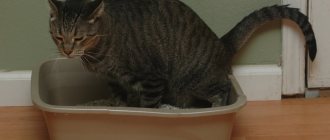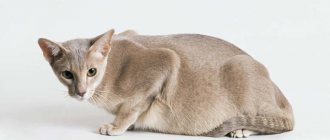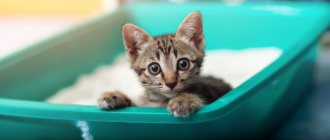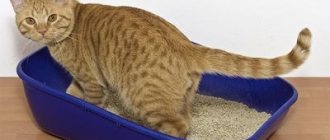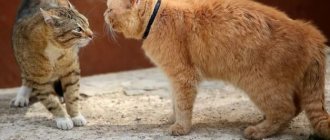- 2 First aid
Causes of foam and increased salivation in cats
Foaming from the mouth of a four-legged pet is usually associated with excessive saliva production. Often the causes of foamy vomiting are quite harmless, and it will not be difficult to identify them yourself at home. However, sometimes such a problem can arise due to a factor that seriously threatens the health and life of the pet. Pathological causes of foam coming out of the mouth in a cat must be promptly identified and eliminated.
Toxicosis during pregnancy
Like women, cats experience toxicosis during pregnancy. This painful condition is often accompanied by foam at the mouth. Typically, a pregnant pet produces foamy drool after eating or sleeping. If this happens after feeding, the stomach contents expelled by the cat may contain pieces of incompletely digested food. The awakened expectant mother vomits transparent foam. This is a normal phenomenon and does not require special measures. When the pet's toxicosis ends, it will disappear by itself.
Prevention
It is always easier to prevent a disease than to treat it later, so to maintain your pet’s health you need to follow simple preventive measures:
- To prevent foam from appearing in the corners of the mouth, you need to regularly brush your pet's fur.
- The cat's food should have a fairly soft consistency. If your pet eats bones, you need to make sure that they do not injure the mucous membranes of the mouth, esophagus and stomach.
- Regular use of anthelmintic drugs will help avoid this problem, since sometimes a large accumulation of parasites leads to foamy discharge in the kitten.
- It is necessary to do regular medical examinations, which will help to notice the impending danger and begin timely treatment.
- It is necessary to monitor what your pet eats. If your cat is walking outside, you can hang a bell around its neck to prevent the possibility of poisoning from a sick mouse or bird.
- You need to buy food and medicine in specialized places, because there are currently many counterfeits on the market that can lead to a similar problem.
Regular examination and proper care of the animal will help to avoid such troubles, which frighten not only the owner, but also the pet.
When to start sounding the alarm
Vomiting blood in a cat: reasons, what to do
In addition to physiological reasons, there are situations when it is worth acting immediately so as not to aggravate the situation and give the animal a chance for a further healthy life. There are a number of pathological health problems that can cause cats to foam at the mouth.
Epilepsy
This disease is caused by a serious pathology of the brain. To identify epilepsy, you should know what its main symptoms are:
Epilepsy in a cat
Epileptic seizures in cats can occur with different frequency: in some - once a week, and in others - 1-2 times a year.
Attention! Sometimes the foamy growths may turn pink, a sign that the tongue or the outer part of the cheeks was bitten during the seizure.
Poisoning
The appearance of foamy formations can be caused by poisoning of the cat, for example, household chemicals, flower poisons, poor-quality food, or something else. Symptoms of poisoning are as follows:
- diarrhea;
- nausea and vomiting;
- complete apathy or, on the contrary, irritation;
- dilation of the pupils is observed;
- body temperature below 38 degrees;
- tachycardia;
- unsteady gait.
Plague
The scientific name of the disease is “panleukopenia”, and in common parlance it is feline distemper.
To recognize this disease, you should pay attention to the following symptoms:
- high body temperature, reaching 41-42 degrees;
- vomiting with foam, mucus or blood;
- urine becomes darker;
- one or both eyes water and purulent discharge occurs;
- the cat completely refuses water;
- frequent and intermittent breathing;
- The cat looks for a distant corner in the house, where it then lies for a long time.
For reference: contrary to popular belief, feline distemper is not dangerous to humans. Therefore, the animal owner can and should help the pet.
Infections
Infectious diseases can provoke foamy discharge from the mouth, and the worst among them is rabies.
The disease can be mild or severe. During a mild form, the animal becomes apathetic, afraid of light and refuses any food. In the acute form, there is excessive affection towards the owner, which gradually develops into aggression and attack. Also, the cat may eat inedible objects, the eyes become cloudy, the pupils are dilated, and saliva is released profusely.
Important! Rabies is dangerous to humans. If you have any suspicions, after being bitten by a cat with symptoms of the disease, you should immediately go to the hospital for qualified help. Once the virus has penetrated the nerve fibers, the process becomes irreversible.
Today there is no cure for rabies and therefore this disease ends in the death of the animal.
Gastrointestinal diseases
Foam formations can occur in the presence of gastritis, pancreatitis, enteritis, ulcers and other problems. Each of the diseases has its own symptoms, but common ones include constipation, diarrhea, flatulence, pain, complete lack of appetite, vomiting with blood, as well as deterioration in the appearance of the animal.
Gastrointestinal problems in animals
What to do
- If a cat is foaming at the mouth and the owner knows exactly the cause (physiological symptom), no special treatment is required.
- Stop treating your cat with bitter medications and replace them with others.
- To improve the removal of hairballs, it is advisable to purchase a special paste (gel) or give your pet a teaspoon of Vaseline.
- Household chemicals, medicines, poisons, fertilizers, house plants that are dangerous to your pet must be stored out of reach of them. Do not feed your cat human food (onions, chocolate, dough, raisins).
- If a foreign body, pathological changes in the oral cavity, an infectious disease, or head injuries are detected, you must seek help from a veterinarian.
- If the cat starts foaming and has convulsions (epileptic seizure), you need to wait until the cat’s seizure ends, laying it on a flat surface and providing it with rest, then taking it to a veterinary hospital. During transportation, it is necessary to ensure that the cat does not choke. The disease is severe and cannot be treated. You can only alleviate the animal’s condition a little.
- In case of poisoning, it is necessary to induce a gag reflex (a teaspoon of hydrogen peroxide inside or salt on the tongue on the tip of a teaspoon, apomorphine), give a sorbent (activated carbon, sorbex, smecta) and a laxative (Glauber's salt or Epsom salt). Then it is advisable to turn to professionals for help.
- If worms are found in the vomit, be sure to consult with a veterinarian about the selection of an anthelmintic drug (drontal, prazicide, azipirin, praten, febtal).
If foam and saliva are released from the mouth, owners must immediately contact a veterinarian in such cases.:
- The discharge is not one-time, but multiple.
- There are accompanying symptoms (the cat feels sick, has severe vomiting with impurities, convulsions, paralysis, high fever, etc.).
- The general condition of the animal changes for the worse.
In what cases is the help of a veterinarian needed?
Foamy vomiting in a pet is not always a harmless phenomenon. In some cases, the speed of reaction of the owner of a cat that is vomiting foam determines its future fate and even its life.
Consultation with a veterinarian is required in the following situations:
- lethargy, apathy, sleep disturbance, lack of response to external stimuli, decreased motor activity;
- partial or complete loss of interest in food;
- indigestion (vomiting, diarrhea or constipation);
- foul odor and the appearance of ulcers in the mouth;
- foreign inclusions in foamy vomit (blood, bile, mucus);
- weight loss;
- signs of body dehydration (dehydration);
- rhinitis;
- photophobia;
- increased body temperature;
- epileptic seizures;
- muscle cramps, paralysis;
- greenish vomit;
- discharge from the eyes and nasal passages;
- icteric staining of the mucous membranes;
- incoordination of movements.
Share with friends!
Foam after giving medicine: is it necessary to panic?
Inept giving of tablets, drops in the mouth or suspension by the breeder himself in almost 100% of cases provokes foamy, profuse discharge from the mouth. This is explained by the effect of a bitter taste on the taste buds and thus the cat tries to get rid of the medicine that has entered the oral cavity.
The worst that can happen is that the required amount of the drug does not enter the body and the effect will be insignificant or absent. Therefore, if the owner is not confident in his dexterity, it is better to bring the cat to a veterinary clinic or call a doctor at home by phone, around the clock.
Let's understand the reasons
There are many reasons why an adult cat or kitten foams. However, if this phenomenon is detected, it is important to make sure that the pet is healthy. You need to pay attention to other symptoms, monitor the animal and, if necessary, contact a veterinary clinic. Do not rush to do something without understanding the situation, and without the recommendation of a specialist.
So, foam can go if:
- this is the result of stress or severe fear;
- this is how severe pain often manifests itself;
- poisoning;
- when exposed to bitter substances, for example, often from bitter medicines;
- The cat cleanses the stomach of fur in this way;
- the animal has choked or there is a foreign object in the mouth;
- dental problems;
- gastrointestinal diseases (enteritis, hepatitis, etc.);
- viral diseases (calcivirosis);
- brain damage, for example, a blow, bruise;
- heart attack;
- sign of rabies.
Vomit color
In order to establish the cause, you need to pay attention to the color of the vomit. If your cat has white foam mixed with fur, then you don’t have to worry - this is a natural process of self-cleaning of the stomach. To prevent this from happening again, it is important to regularly brush your pet and remove hair, especially during shedding.
White foam can indicate an empty stomach, for example, this happens in the morning before breakfast if a cat or baby is hungry. But if vomiting white foam is repeated frequently, this may indicate a serious stomach illness; the animal should be shown to a doctor.
If the foam is green, then the cat may have simply eaten grass or produced too much bile. If it occurs frequently, it is a sign of infection. Frequent gagging and foaming cannot be considered harmless. It is important to remember that against the background of general weakness and apathy, this may be a symptom of plague or panleukopenia. It is important to do an analysis right away.
The discharge of white foam with blood cannot be ignored. If small clots of bright blood are visible, this may indicate an injury in the mouth or esophagus; the cat may have been injured or swallowed an object. If the foam is brown from blood, then the bleeding is internal, and your pet needs to be shown to a doctor immediately. This may be an injury to the walls of the stomach or an exacerbation of gastritis.
Vomiting foam with a yellow tint may indicate that bile has entered the stomach. The walls of the stomach react to this manifestation by vomiting. If the symptom is repeated more than once, then this is due to a chronic disease of the gallbladder, liver or intestines. This is often due to overfeeding the pet with fatty heavy foods and eggs. Sometimes this phenomenon is provoked by chemical additives from industrial feed. It is necessary to check these bodies.
Sorry, there are no surveys available at this time.
Can vomiting be prevented?
To prevent vomiting you need to:
- periodically treat the cat for worms;
- balance the diet;
- think over the feeding regime;
- undergo a preventive veterinary examination annually and undergo routine vaccinations against infections.
If vomiting is caused by the accumulation of wool in the stomach, then special foods or pastes will help speed up its removal from the digestive tract.
It will not be possible to prevent the ingestion of wool, but you can reduce its entry into the stomach. This can be done with the help of combs, mitten brushes, and furminators.
Poisoning
No matter how the owner monitors his pet’s diet, the cat can still swallow any toxic substance. Also, poisoning may not be of a food nature and, for example, occurs due to the absorption into the skin of poisons intended to eliminate fleas.
Common signs of poisoning are:
- Diarrhea;
- unsteady gait (swaying from side to side);
- frequent foamy vomiting.
Advice! Gastric lavage will help alleviate this condition of the animal. They can do it in any veterinary clinic under the strict supervision of doctors.
Diagnosis and treatment
When contacting a veterinary clinic, you need to provide the specialist with the following information:
- What did the cat feed, were there any changes in the diet.
- How often did vomiting occur?
- Are there any chronic diseases or infections in the animal that the owner is aware of?
This will help establish an accurate diagnosis and take the necessary measures.
Diagnosis of the pathological condition of a cat is as follows:
- analysis of the type and consistency of vomit;
- examination of the cat, analysis of the general condition;
- laboratory tests of blood, urine;
- Ultrasound of the abdominal cavity, kidneys.
The treatment regimen is selected depending on the established diagnosis. It includes drug therapy and measures to prevent dehydration.
During the treatment of vomiting in a cat, a special diet is necessary. Food should be semi-liquid. Feed your pet more often, in small portions. Meat should only be given boiled and chopped. After stabilization of the condition, the transition to the usual diet should be gradual.
Questions from a veterinarian to help make a diagnosis:
- diet for the entire time, over the last 2 days, were there any changes;
- presence of appetite;
- amount of vomit, what it consists of;
- chronic diseases.
Take the following tests:
- biochemical analysis of blood and urine;
- Ultrasound to analyze intestinal integrity;
- x-ray to exclude tumors and foreign objects;
- stool analysis for worms.
To understand what actually caused the vomiting, the doctor must find out some details from the owner:
- When the vomiting started.
- What has the cat been eating lately? Have there been any changes in his diet? How much did he eat?
- How often does vomiting occur?
- How much vomit comes out and its composition.
- Does the cat have any chronic or infectious diseases?
- How the animal eats and drinks.
- Cat behavior.
- Frequency of going to the toilet.
In addition, the doctor must examine the animal. Sometimes, to make a diagnosis, it is enough to obtain information from the pet owner and palpate the abdomen. If this is not enough, the doctor will order a urine and blood test.
Some clinics prefer to do a full range of diagnostic measures, which includes x-rays of the kidneys and ultrasound of the abdominal cavity.
Treatment depends entirely on the diagnosis. Mostly medications are prescribed, as well as measures aimed at preventing dehydration.
There are several treatment methods:
- If vomiting is caused by a malnutrition, then a change in diet and medications that restore the intestinal microflora will be prescribed.
- For gastritis, medications are also prescribed to help restore digestion.
- If the doctor discovers that the cat is infected with worms, then in addition to restoring the water-salt balance, antiparasitic drugs will be prescribed.
- In case of poisoning, the cat's stomach will be rinsed and appropriate medications will be prescribed to help remove toxins from the body.
- If vomiting is associated with a respiratory disease or with an inflammatory process, then the cause of vomiting will also be treated first.
- Frequent vomiting during pregnancy also requires therapeutic measures. Usually the animal is given IV drips with glucose and vitamins to support the body of the expectant mother and her unborn kittens.
- In case of renal failure, first of all, they try to normalize the functioning of this organ. To do this, the cat is put on a low-protein diet and prescribed medications that lower blood pressure.
- Vomiting during estrus is not treated, but only medications are prescribed to prevent the animal from dehydration. If a cat undergoes such a period and is constantly accompanied by vomiting and diarrhea, the veterinarian may suggest sterilization to save the animal from suffering and possible negative consequences.
The treatment strategy is to eliminate not only the signs of pathology, but also its causes. Therefore, the cat owner must understand in what cases and how he can help the cat on his own, and when it is necessary to immediately seek help.
The cat is drooling from his mouth: what to do at home, prognosis of the course of the disease
Our recommendations apply only to home care after visiting a veterinarian.
Hypersalivation in cats is a dangerous symptom, and you cannot help your pet yourself - it can only worsen the situation.
First of all, be sure to call your doctor and take any measures only on the basis of consultation.
During your visit to the clinic, all necessary treatment, medications, care and feeding regimen will be prescribed by your doctor. It is necessary to strictly follow the instructions and regularly contact the veterinarian.
The prognosis depends greatly on the disease that has been diagnosed.
If your cat is suspected of having rabies, it must be quarantined at the Animal Disease Control Station.
Dental problems are usually solved with surgery and cleaning of the mouth. Your doctor may prescribe special medications for home care.
Recovery from poisoning depends largely on how quickly the poisoning was identified and what substance caused it.
The prognosis for kidney and liver disease is guarded and lifelong treatment is often required.
When diagnosing a malignant tumor, the prognosis depends on the type of tumor.

